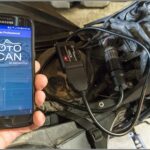Experiencing issues with your OBD2 port on your 2010 BMW 335i can be frustrating, especially when you need to run a diagnostic scan for inspections or troubleshooting. Many BMW 335i owners have encountered situations where generic OBD2 scanners fail to connect, while BMW-specific tools work without a hitch. If you’re facing this problem, a common culprit to investigate first is the fuse that controls your OBD2 port. This guide will help you pinpoint the correct fuse and explore other potential causes for OBD2 port connectivity problems in your 2010 BMW 335i.
Understanding the OBD2 Port and Fuse Location in Your BMW 335i
The On-Board Diagnostics II (OBD2) port is a crucial interface in your BMW 335i. It allows mechanics and car owners to access the vehicle’s computer system for diagnostics, emissions testing, and performance monitoring. This port is typically located under the dashboard on the driver’s side.
Like many electronic components in your car, the OBD2 port is protected by a fuse. Fuses are designed to protect electrical circuits from overcurrent, and a blown fuse is a common reason for an OBD2 port to stop working. Locating and checking the correct fuse is a simple first step in diagnosing OBD2 port issues.
For a 2010 BMW 335i, the fuse responsible for the OBD2 port is typically Fuse 2. This fuse is located in the glove compartment fuse box. However, it’s worth noting that BMW fuse configurations can sometimes vary slightly depending on the specific model and production date. Therefore, always consult your BMW 335i owner’s manual for the most accurate fuse location and assignment for your vehicle. Additionally, some sources also point to Fuse 47 as being related to the OBD system in certain BMW models, so checking both is advisable.
Image alt text: A close-up view of the Junction Box Electronics (JBE) module inside a BMW 335i, highlighting the fuse box and connector areas potentially linked to the OBD2 port.
Step-by-Step Guide to Check the OBD2 Port Fuse
Before you start, ensure your vehicle is turned off. Here’s how to check the fuses related to your OBD2 port:
- Locate the Glove Compartment Fuse Box: Open your BMW 335i’s glove compartment. On the back or side, you should find a panel that provides access to the fuse box.
- Identify Fuse 2 and Fuse 47: Refer to the fuse diagram, usually located inside the fuse box cover or in your owner’s manual. Locate the positions for Fuse 2 and Fuse 47. These are typically small, blade-type fuses.
- Inspect the Fuses: Use a fuse puller (often included in the fuse box) or needle-nose pliers to carefully remove Fuse 2 and Fuse 47.
- Check for a Blown Fuse: Examine each fuse. A blown fuse will usually have a broken wire inside or appear burnt.
- Replace if Necessary: If either Fuse 2 or Fuse 47 is blown, replace it with a new fuse of the same amperage rating. Important: Never use a fuse with a higher amperage rating, as this can damage your vehicle’s electrical system.
- Test the OBD2 Port: After replacing the fuse(s), try connecting your OBD2 scanner again to see if it now connects and powers on.
Further Troubleshooting if the Fuse Isn’t the Problem
If you’ve checked and replaced the fuses, and your OBD2 port is still not working correctly, or if it only works with BMW-specific tools, the issue might be more complex. Here are other potential causes to investigate:
- OBD2 Port Wiring Issues: Damage to the wiring harness or connectors leading to the OBD2 port can prevent proper communication. Check for any visible damage to the wires around the OBD2 port and trace them back to the Junction Box Electronics (JBE).
- Junction Box Electronics (JBE) Problems: The JBE is a central electrical module in your BMW. Issues within the JBE itself can sometimes affect OBD2 port functionality.
- CAN Bus Communication Issues: The OBD2 port relies on the Controller Area Network (CAN bus) for communication. Problems with the CAN bus system in your BMW can disrupt OBD2 port function. The original poster mentioned K-CAN, which is relevant to earlier E9x models. While 2010 models are typically D-CAN, variations and wiring anomalies are possible.
- Scan Tool Compatibility: While less likely if you’ve tried multiple generic scanners, it’s still worth ensuring your generic OBD2 scan tool is compatible with the OBD2 protocols used by your 2010 BMW 335i. However, the fact that a BMW-specific tool works suggests the port itself is functional.
- Pin Configuration Anomalies: As highlighted in the original post, there could be unusual wiring configurations in some vehicles, especially around production date changes or specific models like convertibles (E93). Comparing your OBD2 port pinout to standard diagrams and your Bentley manual is a good step.
Image alt text: A detailed wiring diagram of a BMW OBD2 port connector, emphasizing pin assignments and their roles in CAN bus communication protocols like K-CAN and D-CAN.
Seeking Professional Help
Diagnosing OBD2 port issues can sometimes require specialized tools and knowledge, especially when it goes beyond a simple fuse replacement. If you’ve tried the steps above and are still having trouble, it’s recommended to consult a qualified BMW mechanic or a trusted automotive electrician. They can perform more in-depth diagnostics, including checking wiring continuity, CAN bus signals, and using professional-grade scan tools to pinpoint the root cause of the problem.
By systematically checking the fuses and considering other potential issues, you can effectively troubleshoot OBD2 port connectivity problems in your 2010 BMW 335i and get your diagnostic capabilities back online.
